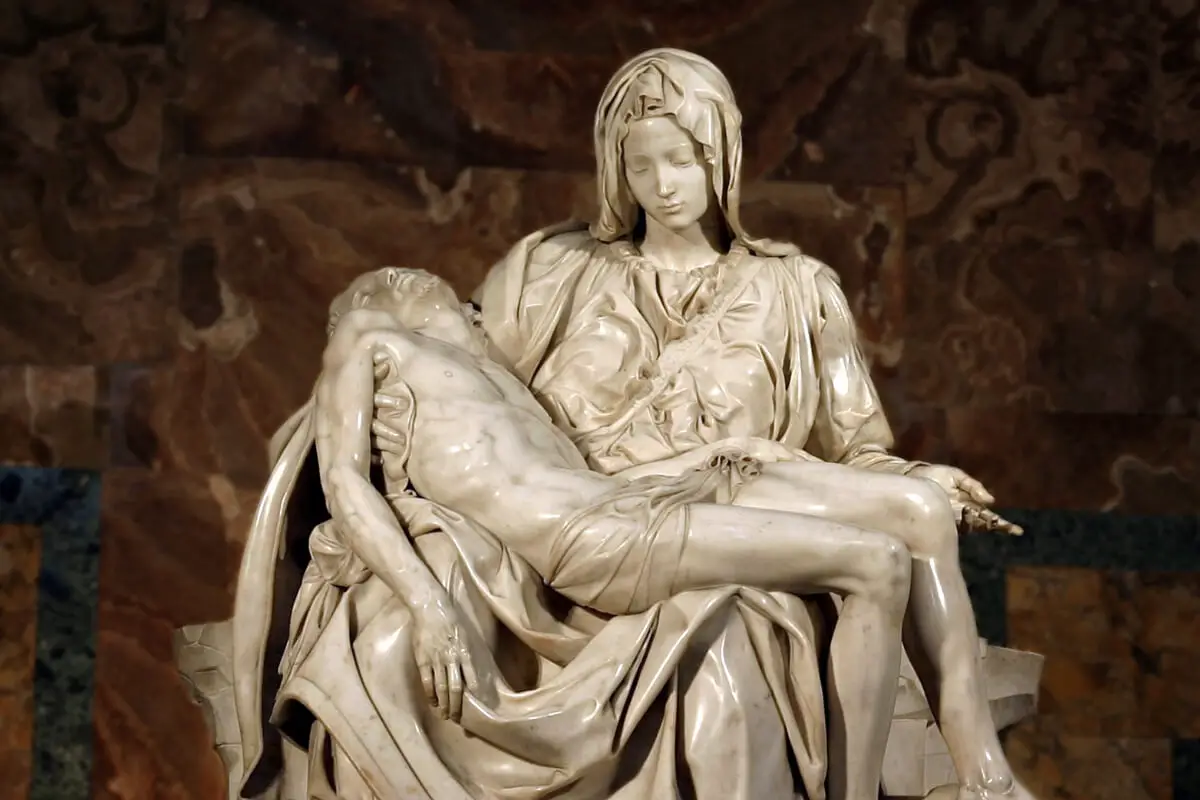Michelangelo Buonarroti—a name that resonates with the echoes of artistic genius—left an indelible mark on the world during the height of the Renaissance, a time of unparalleled flourishing in art and thought—this period of rebirth for culture and intellect cradled the emergence of some of the most influential figures in art history. Among those giants stood Michelangelo, whose sculptures came to define not only the artistic ideals of his day but also the very essence of human expression and form.
In this essay, we embark on a journey to uncover the historical context that shaped Michelangelo’s sculptures, delve into the intricacies of his iconic masterpieces, and explore the lasting impact of his revolutionary techniques—a legacy preserved in the stone of his creations and the spirit of art itself.
Table of Contents
- Historical Context of Michelangelo’s Sculptures
- Analysis of Iconic Michelangelo Statues
- Michelangelo’s Influence on Art and Sculpture
- Conservation and Display of Michelangelo’s Statues Today
- Related Questions
Historical Context of Michelangelo’s Sculptures
Michelangelo and the Renaissance: Shaping the Supremacy of Sculpture
Amidst the profound awakening of the Renaissance, sculptural work underwent an extraordinary evolution, deeply influenced by the revival of classical antiquity and humanist philosophy.
At the heart of this transformation stood Michelangelo Buonarroti—a towering genius whose sculptures transcended mere craftsmanship and ventured into the realms of the divine.
The Renaissance period, a golden age of art and thought from the late 14th to the 17th century, brought about a renewed interest in the art and literature of ancient Greece and Rome, emphasizing humanism, proportion, and balance. These principles set the stage for Michelangelo’s sculptural mastery, a profound embodiment of Renaissance ideals.
Michelangelo’s exposure to classical art was pivotal. As a young apprentice in the Medici family’s Florentine garden, which housed a vast collection of ancient statues, he honed his craft by carefully studying and emulating these revered forms.
Florence’s stabilized social and political climates allowed him to immerse himself entirely in perfecting the human figure, a critical element that defined Renaissance art.
The essence of Michelangelo’s work was capturing the tension and potential of the human form—termed ‘terribilità’—an idea encapsulated in the unfinished series known as the ‘Prigioni’ or ‘Slaves.’
These haunting figures, seemingly struggling to break free from their marble imprisonment, powerfully convey the Renaissance aspiration to liberate the human body and soul, celebrating the boundless capabilities of humanity and the intuitive understanding of anatomy that only an artist-sculptor of Michelangelo’s caliber could achieve.
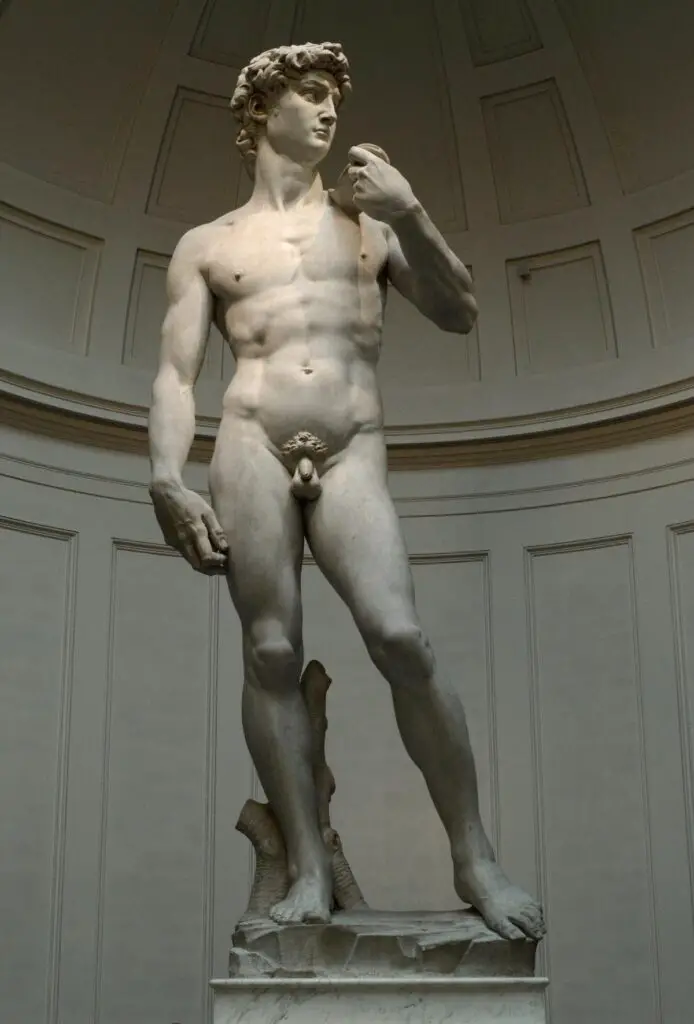
Michelangelo’s most iconic sculpture, ‘David,’ embodies the influence of Renaissance humanism and its focus on the idealized form. Standing seventeen feet tall, ‘David’ is not just a biblical hero but a symbol of the Florentine Republic—an epitome of the strength, beauty, and courage in human nature. Through ‘David,’ Michelangelo realizes the Renaissance crusade to harmonize and glorify the physical and the spiritual.
Such heights of achievement were made possible by the shift in patronage from solely ecclesiastical commissions to those from powerful families like the Medici and political entities keen to use art as a symbol of their prestige and intellectual prowess.
This environment amplified the artist’s status from mere craftsman to intellectual, allowing virtuosos like Michelangelo the leeway to infuse their works with profound philosophical and emotional depth.
Adopting contrapposto—a technique revived from classical sculpture where the figure stands with most of its weight on one foot—allowed Michelangelo to instill a sense of movement and life into his works that echoed the dynamic spirit of the Renaissance.

Witness this in the rhythmic composition of ‘The Dying Slave,’ where the languid pose emanates the complexity of human emotion and eternal struggles.
Furthermore, his work on the Medici family tomb in the New Sacristy of San Lorenzo demonstrates how Renaissance artists like Michelangelo reflected their meditation on life and the afterlife through sculpture.
The allegorical figures, ‘Dawn,’ ‘Dusk,’ ‘Night,’ and ‘Day’ symbolize the inevitable passage of time, a theme poignant in the Renaissance understanding of humanism, history, and personal introspection.
In conclusion, the Renaissance was not just a backdrop but the clay that sculpted and immortalized Michelangelo’s legacy. His works stand as testaments to the era’s enlightened spirit and milestones in the eternal pursuit of bridging the human with the sublime.
Through the hands of a sculptor, Michelangelo gave form to the restless and profound spirit of the Renaissance—making the marble breathe and inviting us to ponder the depths of our existence.
Analysis of Iconic Michelangelo Statues
Delving further into the sculptural prowess of Michelangelo, one uncovers the subtle nuances and emotional intensity that each of his statues exudes. A prime exemplar is “La Pietà,” the quintessential sculpture embodying the essence of the Renaissance ideals married to unparalleled craftsmanship.
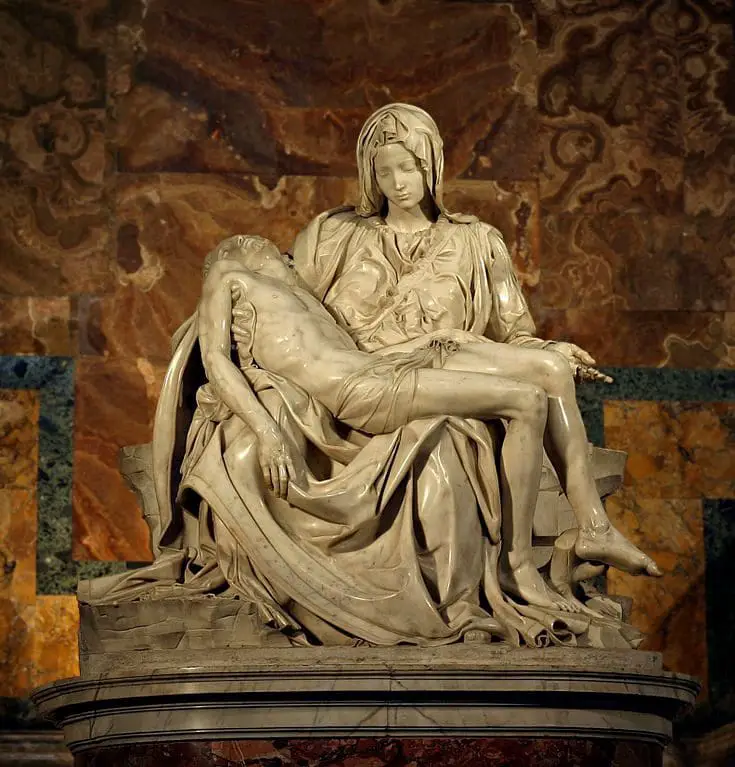
This masterpiece, housed in St. Peter’s Basilica, radiates with a poignancy that nearly transcends the marble from which it is carved. Here, facial expressions and drapery merge to convey the profound sorrow of the Virgin Mary cradling the lifeless body of Christ.
Michelangelo’s command over the stone is evident, presenting a dichotomy of strength and tenderness, vividly recalling the artist’s assertion that the form was always there within the stone, his hands simply exacerbating its release.
Exploration of “Moses” from the tomb of Pope Julius II brings to light Michelangelo’s deft ability to imbue his figures with a dynamic inner life. The seated prophet is charged with a vigor that defies the medium’s confines.
The intricate carving of Moses’ flowing beard and the veins running down his mighty arms showcase Michelangelo’s commitment to anatomical exactitude. Yet, it is in Moses’ gaze—a piercing look of divine communion—that the work’s emotional core is laid bare, demonstrating how the artist could evoke narrative through the sheer force of expression.
In the tombs of Giuliano and Lorenzo de’ Medici, the allegorical figures—Day, Night, Dawn, and Dusk—carved with resounding inventiveness reiterate Michelangelo’s skill of using posture and symbolism to express complex philosophical ideas.
Night, a female figure shrouded in darkness, conveys a somber intuition about mortality, her sleep as a metaphor for death. Each of these figures is a triumph of personification, their postures and physical forms enveloping the viewer in Michelangelo’s ruminations on time and the human condition.
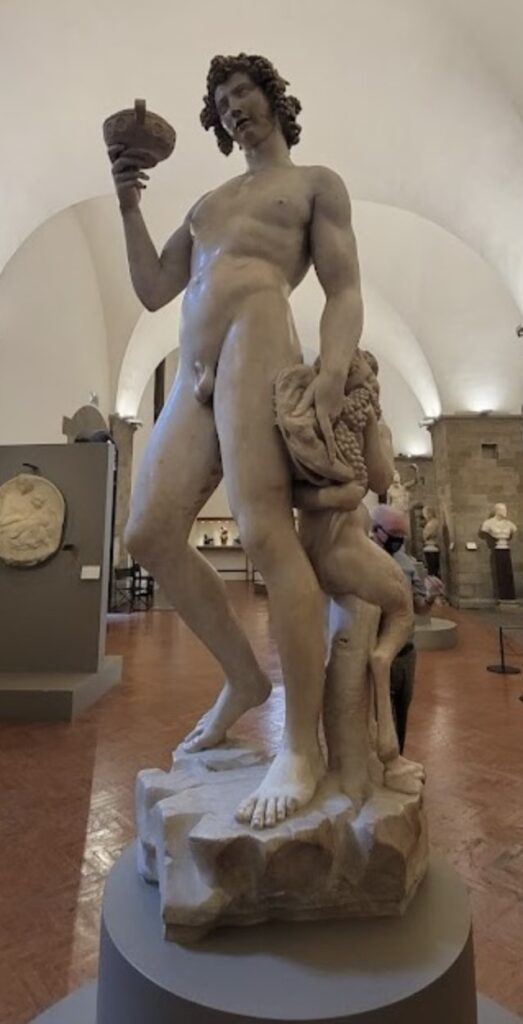
A less remarked upon yet equally fascinating statue is “Bacchus.” In this work, Michelangelo challenges the viewer by depicting the god of wine, which opposes traditional classical representations. Bacchus stands in a relaxed pose, his inebriated state captured with an almost unsettling realism.
The wayward glance and off-balance stance interplay with the detailed carving of the grapes and vine leaves, resulting in a figure embodying youthful exuberance and a cautionary exposition on excess.
The sculptures of Michelangelo exist not only as a testament to the artist’s genius but also as dialogues etched in stone that continue to influence conversations about art, humanity, and philosophy.
In each piece, observers find an invitation to share in the depths of thought and feeling experienced by the Maestro. The statues, boundless in their marble confines, stand as Beacons Across Time, affirming the potential of human expression and the transcendent power of art.
Michelangelo’s Influence on Art and Sculpture
Michelangelo Buonarroti’s sculptural mastery does not merely reside in the history books as an echo of the Renaissance; it resonates powerfully through the corridors of time, shaping the hands and chisels of countless artists who followed.
Understanding how this titan of art has influenced subsequent generations requires delving into the very essence of his approach to sculpture.
Exquisite detail and emotional resonance are hallmarks of Michelangelo’s work, but so too is the artist’s striking ability to render stone so supple it seems on the verge of breath. Take “La Pietà,” located in St. Peter’s Basilica – the tenderness and pathos captured in marble transcend the confines of religion and enter the universal human experience, setting a standard for a sculptural narrative that successors strive to achieve.
The physical manifestation of sorrow and devotion etched on Mary’s face and the limp body of Christ have inspired artists attempting to capture the complexity of the human experience.
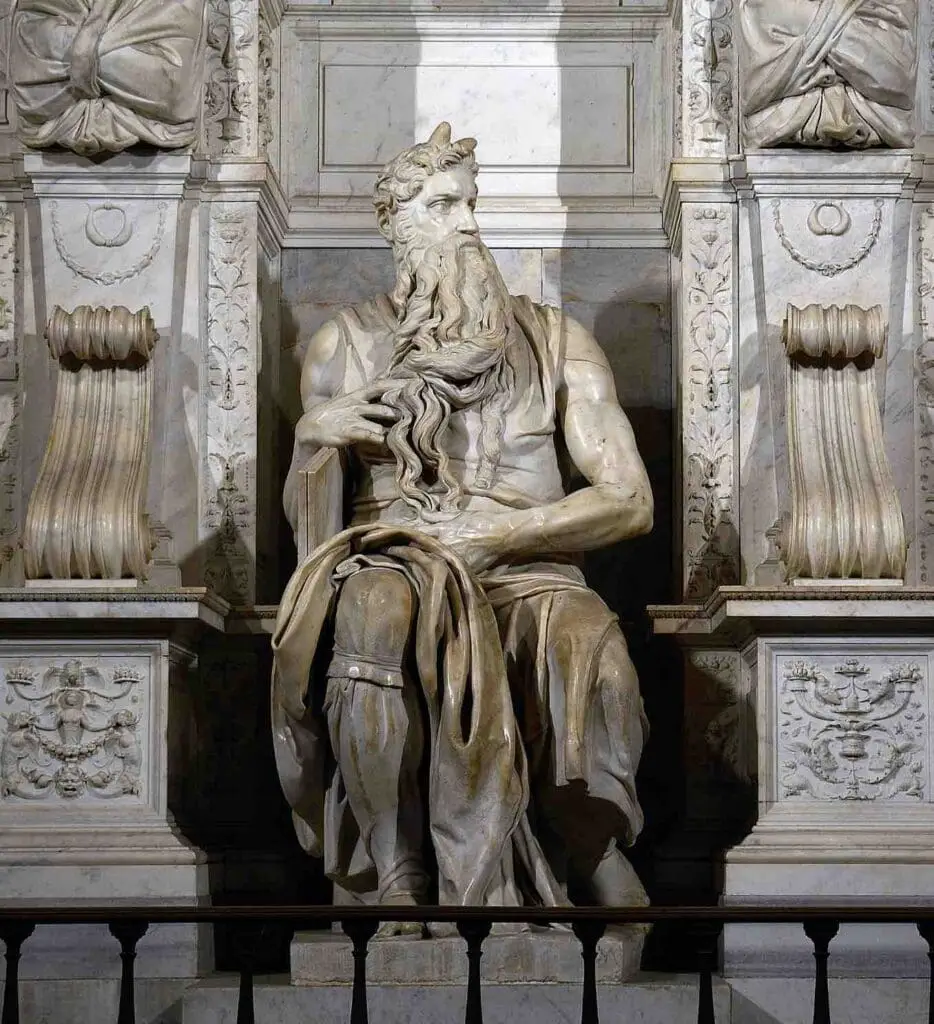
Similarly, “Moses,” with its intense gaze and veins palpitating with potential energy, challenges sculptors even today to imbue their creations with a sense of inner life and poised motion. Michelangelo’s legacy provokes artists not to create figures but to instill in them a palpable presence that compels the viewer to engage in a silent dialogue with the stone.
Furthermore, the allegorical figures crafted for the tombs of Giuliano and Lorenzo de’ Medici, with their expressive postures and embedded symbolism, have provided a blueprint for incorporating philosophical concepts into physical form.
These sculptures encourage contemporary artists to explore posture as a medium to express complex, abstract ideas, transforming static material into visual narrations of thought.
Michelangelo’s portrayal of a drunk “Bacchus” defied traditional characterization, challenging norms and prompting future sculptors to reconceptualize mythological and historical figures with personal interpretations.
This appetite for reimagining antiquity through an individual lens emboldened artists to distance themselves from passive reproduction, advocating the personal exploration of subjects.
It is not only in specific artworks that Michelangelo’s influence is felt. His philosophies concerning the sculptural process, notably his belief that the artist’s role is to liberate forms imprisoned within the stone, have imbued sculpture with a sense of pre-birth destiny—a perspective many contemporary sculptors consider when approaching their craft.
From Rodin’s evocative textures and forms to Moore’s abstract interpretations of the human figure, echoes of Michelangelo’s doctrines can be traced. Similarly, artists focusing on the dynamic interplay between light, shadow, and form find precedents in the Florentine master’s tactile surfaces.
The immeasurable contribution of Michelangelo to sculpture cannot be wholly contained in a series of observations but is best witnessed in the living spirit of art that still, to this day, covets the hand of the master.
The dialogue between the past and the present continues, and artists of every generation find fresh nuances in Michelangelo’s works to inform and inspire their unique contributions to the evolution of sculptural art.
It is a testament to the enduring vitality of the sculptural language developed by Michelangelo that we see its influence reflected in the contemporary works surrounding us, each bearing a trace of his indelible touch.
Conservation and Display of Michelangelo’s Statues Today
Eternal Stone, Enduring Challenges
One might be under the impression that marble, an inherently durable material, ensures the perpetual existence of the masterpieces sculpted from it. However, unmatched in their dynamic form and emotional depth, Michelangelo’s statues face a litany of preservation challenges in our era. Environmental factors, physical degradation, and human interference threaten these irreplaceable works of art.
The Detrimental Touch of Time
Marble, while majestic, is susceptible to weathering and erosion. Michelangelo’s famed sculptures have endured not only the intrinsic effects of acid rain, pollution, and fluctuating humidity but also the corrosive touch of time itself. Carved during the early 16th century, these statues have witnessed centuries of changing climates and environmental conditions, compromising their structural integrity and aesthetic splendor.
The Complexities of Restoration
Contemporary art conservators are tasked with deciphering the delicate complexities of Michelangelo’s intentions and historical context to ensure accurate restoration. This responsibility transcends mere repair and extends into the philosophical interpretation of the artist’s mindset.
Each decision in the restoration process balances preserving the original material and maintaining the work’s visual and emotional impact.
The Risks of Human Interaction
Ironically, while the admiration of Michelangelo’s genius attracts crowds to museums and collections housing his work, the presence of visitors introduces physical dangers. Accidental contact, deliberate defacement, and even the cumulative impact of thousands of breaths steadily alter the microclimate around the sculptures. This necessitates prudent measures in visitor management and display conditions.
Scientific Archeology of Art
Cutting-edge technologies, such as high-resolution 3D scanning and microscopic analysis, provide insights into the sculpture’s subsurface conditions, revealing stresses and decay invisible to the naked eye. Such tools aid in developing targeted conservation strategies that preserve the surface and the heart of Michelangelo’s stone.
Reversing the Irreversible?
Every art historian knows that each intervention carries a level of risk. Restorative endeavors run the dangerous gauntlet between success and the irreversible loss of original material or alteration of textural nuances that form the narrative of the sculpture’s life and legacy.
Preventative conservation, therefore, becomes equally as significant, if not more so, in the crusade to safeguard these cultural treasures.
Conscientious Custodianship
We are cultivating a meticulous custodianship over the artifacts of the past, which forms the crux of preservation work. This translates into conducting ethical restorations and educating the public, elevating awareness, and ensuring rigorous environmental controls within museums and galleries.
The challenges faced in preserving Michelangelo’s sculptures symbolize the broader undertaking to maintain the cultural patrimony of our shared human history. These statues are not mere carvings of a bygone time but as ever-present conversations between past genius and present interpretation.
Their enduring resonance relies as much on the craft of current conservators and custodians as on the masterful chiseling of Michelangelo himself. The practices involved in their preservation are an ongoing testament to humanity’s unyielding quest to retain the tangible vestiges of intangible brilliance.
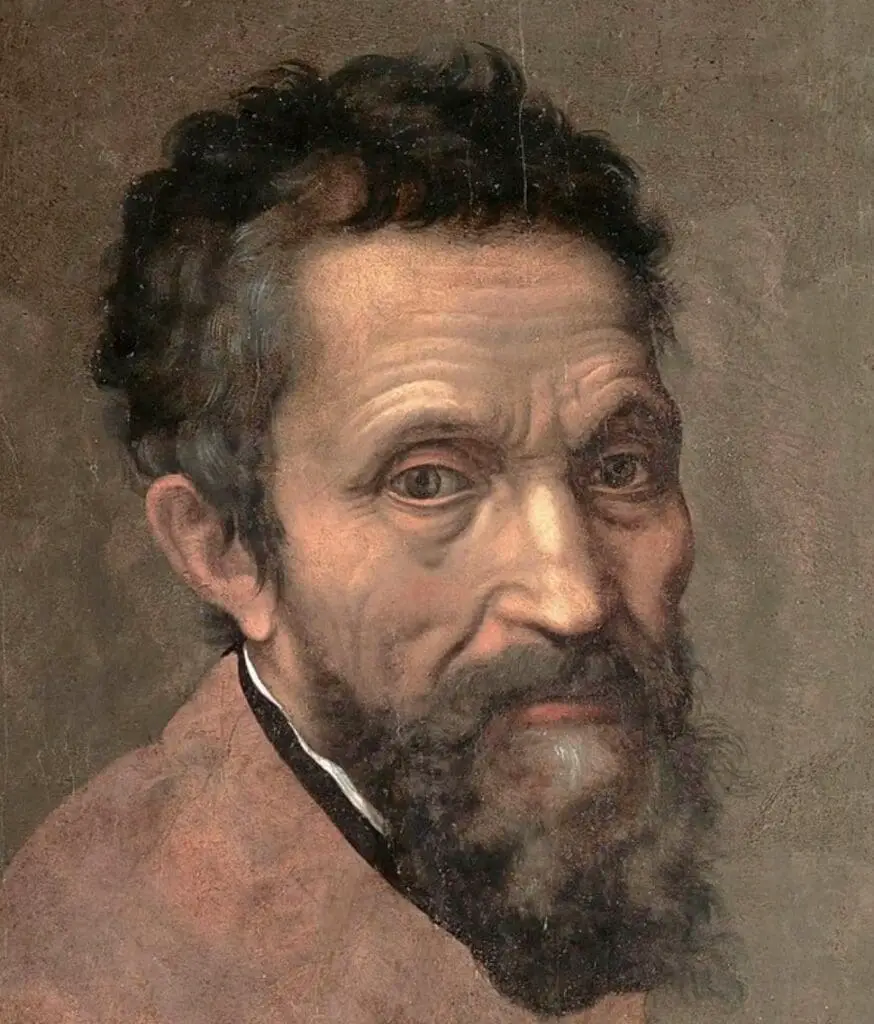
As the custodians of Michelangelo’s legacy, we must ensure the preservation of his marbled masterpieces for future generations to behold. The task is not without its challenges, entailing a delicate balance between the ravages of time and the intervention of contemporary conservation methods.
The resonance of Michelangelo’s sculptures in the halls of museums and in the hearts of admirers stands as a testament to the timeless nature of true artistry. Through these silent stone sentinels, Michelangelo speaks across centuries, compelling us to contemplate the depths of human experience and urging our creative spirits to reach for the transcendent, much like he did with chisel and mallet in hand under the auspices of the Italian Renaissance.
Anita Louise Art is dedicated to art education, great artists, and inspiring others to find and create their art. We love art that uplifts and inspires. #ArtToMakeYouSmile! #ArtToMakeYouHappy!
If you want to see any of my art, you can find out more by clicking here. If you are interested in what inspires me and my paintings, you can discover more by clicking here.
We have a free newsletter and would love you to be part of our community; you can subscribe to the newsletter by clicking here. If you have any questions, I would be happy to talk to you. You can reach me, Anita, by clicking here.
Subscribe to our Anita Louise Art YouTube Channel with great videos and information by clicking here.
Join us for our podcast “5 Minutes With Art.” Spend 5 minutes a week with us to discover and learn about great art and artists. You can find out more about our podcast by clicking here.
Related Questions
The Ten Most Famous Paintings: A Journey In Artistic Triumphs
We have gone through the list of all the important paintings and listed what we see as the 10 most important ones. Many on this list are very famous as the Mona Lisa. Others include one of my favorite American paintings of the American Gothic. Read on as we explore what we see as ten of these most essential paintings ever created.
By clicking here, you can learn more by reading The Ten Most Famous Paintings: A Journey In Artistic Triumphs.
A Canvas Of Words: 100 Inspiring Art Quotes From Great Minds
Art has been essential to human culture and society for thousands of years. It’s an expressive form of communication that transcends language, time, and geography barriers, allowing us to share emotions, perspectives, and visions of the world. Whether you’re an artist, an art lover, or simply someone who appreciates the power of a beautiful piece, there’s a universal language in art that speaks to us all.
By clicking here, you can learn more by reading A Canvas Of Words: 100 Inspiring Art Quotes From Great Minds.
The Important Role Of Art Museums In The Art World
An art museum will help to collect and preserve works of art. They also interpret the art and help to educate us all about art. Many art museums will have programs that allow you to experiment with different art types. The core role of an art museum is to inspire us about art.
You can discover more by reading The Important Role Of Art Museums In The Art World by clicking here.

